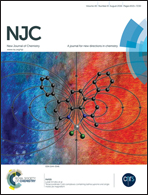Hexahalometallate salts of trivalent scandium, yttrium and lanthanum: cation–anion association in the solid state and in solution†
Abstract
The hexahalide salts, [NnBu4]3[LaCl6], [BMPYRR]3[LaCl6] (BMPYRR = 1-butyl-1-methylpyrrolidinium), [EMIM]3[MX6] (EMIM = 1-ethyl-3-methylimidazolium; M = La, X = Cl, Br, I; M = Sc, Y, Ce, X = Cl) and [EDMIM]3[MX6] (EDMIM = 1-ethyl-2,3-dimethylimidazolium; M = Y, X = Cl; M = La, X = Cl, I) have been prepared and X-ray crystal structures determined for several of them, with a view to probing the effect of varying the trivalent metal ion, the halide and the counter-cation on the structures adopted in the solid state. The crystal structures of the EMIM and EDMIM salts show extensive H-bonding between the halide ligands and organic cations; based upon the H-bonding distances, this appears to be strongest for the [EMIM]3[MCl6] salts, becoming progressively weaker for heavier metal ion or halide. In terms of the cations, changing from EMIM to EDMIM also reduces the strength of the H-bonding. The strength of the cation–anion pairing in solution has also been probed in solution via NMR spectroscopy where possible (45Sc, 89Y and 189La) and, for the EMIM salts, via the shift of δ(H2) relative to [EMIM]Cl at a standard concentration. The trends observed in solution mirror those determined in the solid state.


 Please wait while we load your content...
Please wait while we load your content...